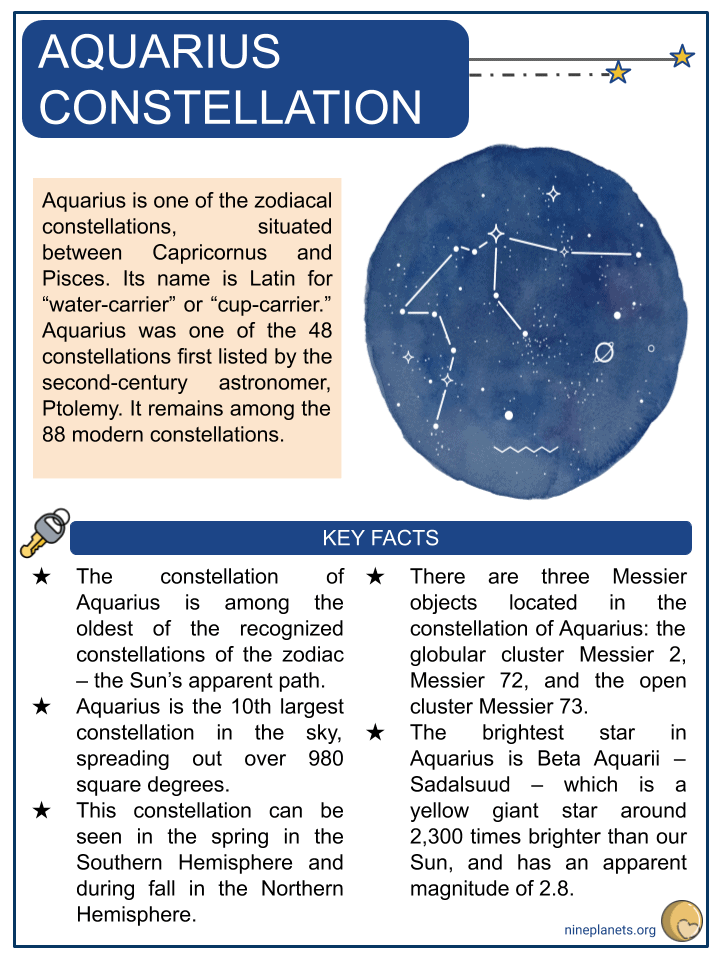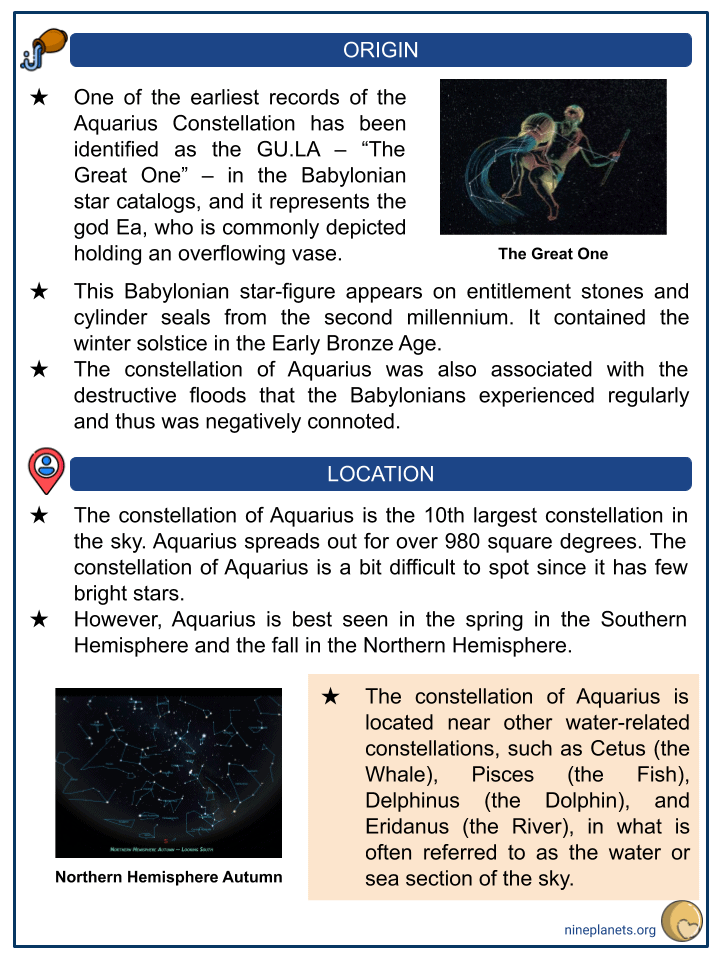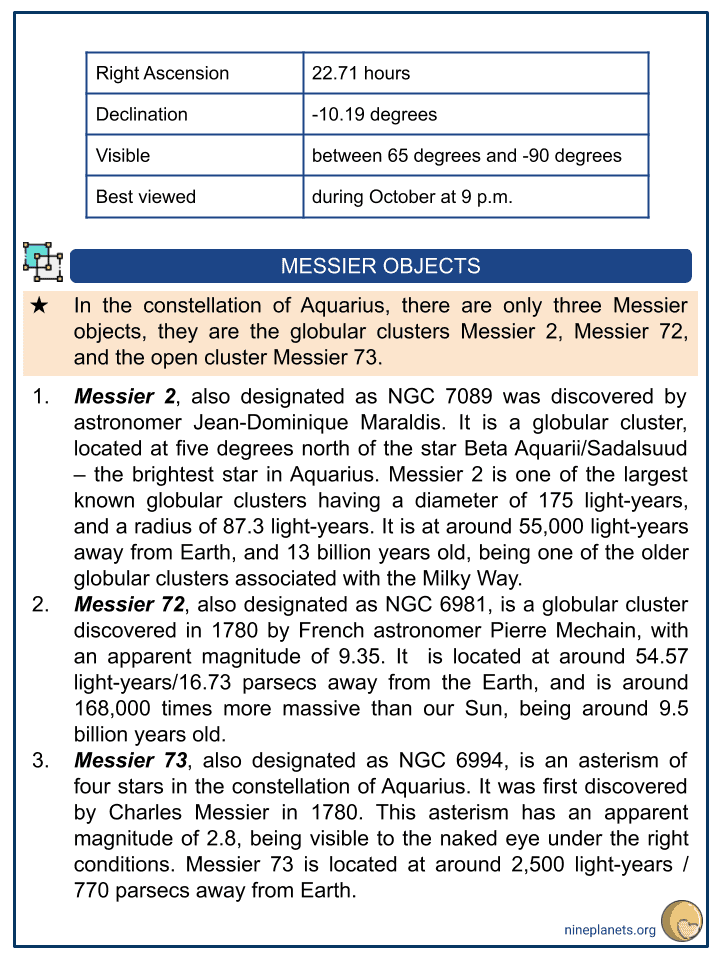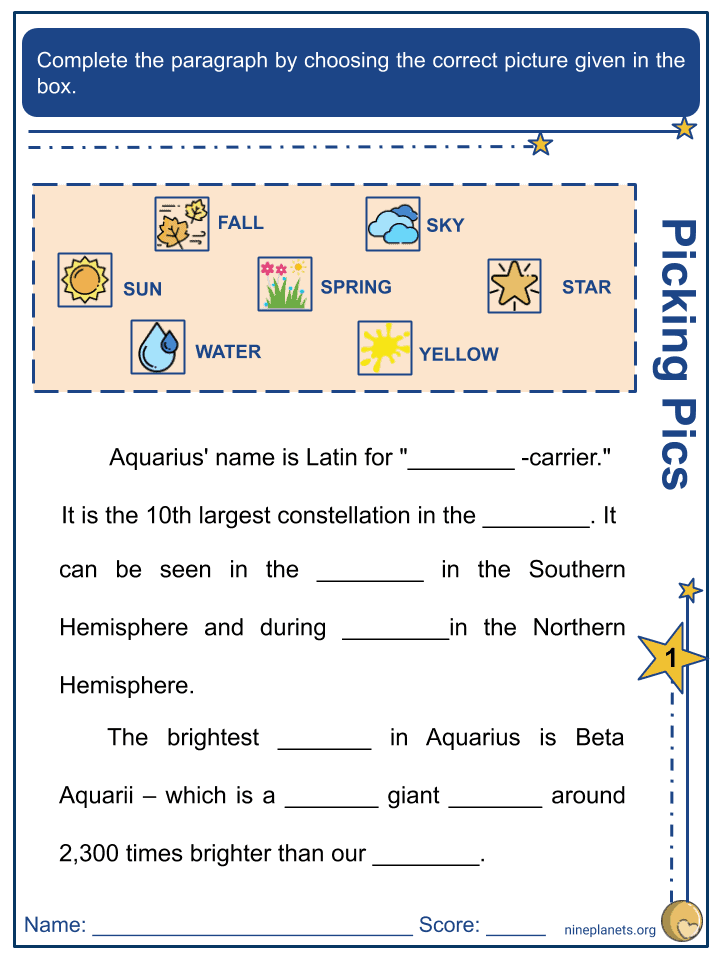Download Aquarius Constellation Worksheets
Click the button below to get instant access to these premium worksheets for use in the classroom or at a home.

This worksheet can be edited by Premium members using the free Google Slides online software. Click the Edit button above to get started.
Download free sample
Not ready to purchase a subscription yet? Click here to download a FREE sample of this worksheet pack.
Resource Examples
Click any of the example images below to view a larger version.




Key Facts & Information
- Aquarius is one of the zodiacal constellations, situated between Capricornus and Pisces. Its name is Latin for “water-carrier” or “cup-carrier.” Aquarius was one of the 48 constellations first listed by the second-century astronomer, Ptolemy. It remains among the 88 modern constellations.
- The constellation of Aquarius is among the oldest of the recognized constellations of the zodiac – the Sun’s apparent path.
- Aquarius is the 10th largest constellation in the sky, spreading out over 980 square degrees.
- This constellation can be seen in the spring in the Southern Hemisphere and during fall in the Northern Hemisphere.
- There are three Messier objects located in the constellation of Aquarius: the globular cluster Messier 2, Messier 72, and the open cluster Messier 73.
- The brightest star in Aquarius is Beta Aquarii – Sadalsuud – which is a yellow giant star around 2,300 times brighter than our Sun, and has an apparent magnitude of 2.8.
Origin
- One of the earliest records of the Aquarius Constellation has been identified as the GU.LA – “The Great One” – in the Babylonian star catalogs, and it represents the god Ea, who is commonly depicted holding an overflowing vase.
- This Babylonian star-figure appears on entitlement stones and cylinder seals from the second millennium. It contained the winter solstice in the Early Bronze Age.
- The constellation of Aquarius was also associated with the destructive floods that the Babylonians experienced regularly and thus was negatively connoted.
Location
- The constellation of Aquarius is the 10th largest constellation in the sky. Aquarius spreads out for over 980 square degrees. The constellation of Aquarius is a bit difficult to spot since it has few bright stars.
- However, Aquarius is best seen in the spring in the Southern Hemisphere and the fall in the Northern Hemisphere.
- The constellation of Aquarius is located near other water-related constellations, such as Cetus (the Whale), Pisces (the Fish), Delphinus (the Dolphin), and Eridanus (the River), in what is often referred to as the water or sea section of the sky.
Messier Objects
- In the constellation of Aquarius, there are only three Messier objects, they are the globular clusters Messier 2, Messier 72, and the open cluster Messier 73.
- Messier 2, also designated as NGC 7089 was discovered by astronomer Jean-Dominique Maraldis. It is a globular cluster, located at five degrees north of the star Beta Aquarii/Sadalsuud – the brightest star in Aquarius. Messier 2 is one of the largest known globular clusters having a diameter of 175 light-years, and a radius of 87.3 light-years. It is at around 55,000 light-years away from Earth, and 13 billion years old, being one of the older globular clusters associated with the Milky Way.
- Messier 72, also designated as NGC 6981, is a globular cluster discovered in 1780 by French astronomer Pierre Mechain, with an apparent magnitude of 9.35. It is located at around 54.57 light-years/16.73 parsecs away from the Earth, and is around 168,000 times more massive than our Sun, being around 9.5 billion years old.
- Messier 73, also designated as NGC 6994, is an asterism of four stars in the constellation of Aquarius. It was first discovered by Charles Messier in 1780. This asterism has an apparent magnitude of 2.8, being visible to the naked eye under the right conditions. Messier 73 is located at around 2,500 light-years / 770 parsecs away from Earth.
Notable Stars
- The constellation of Aquarius, despite its size, has no particularly bright stars. The two brightest stars in Aquarius, Alpha Aquarii, and Beta Aquarii are luminous yellow supergiants of spectral types G0lb and G2lb.
- Beta Aquarii/Sadalsuud is the brightest star in Aquarius, having an apparent magnitude of 2.87. It is 2,046 times brighter than our Sun, having 497% of our Sun’s mass, and around 4700% of its radius. The star is a few degrees cooler than our Sun, having average surface temperatures of around 5,608 K.
- Alpha Aquarii/Sadalmelik is the second-brightest star in Aquarius, being 2,120 times brighter than our Sun. It has an apparent magnitude of 2.94, having 513% of our Sun’s mass, and around 5289% of our Sun’s radius. This star is also cooler than our Sun, having average surface temperatures of around 5,383 K.
- The top 10 brightest stars in the constellation of Aquarius are:
- Beta Aquarii – Sadalsuud – apparent magnitude 2.8
- Alpha Aquarii – Sadalmelik – apparent magnitude 2.9
- Delta Aquarii – Skat – apparent magnitude 3.3
- Zeta Aquarii – apparent magnitude 3.65
- Lambda Aqaurii – Hydor – apparent magnitude 3.72
- Epsilon Aquarii – Albali – apparent magnitude 3.77
- Gamma Aquarii – Sadachbia – apparent magnitude 3.8
- Theta Aquarii – Ancha – apparent magnitude 4.1
- Pi Aquarii – Seat – apparent magnitude 4.57
- Xi Aquarii – Bunda – apparent magnitude 4.7
Other Deep-Sky Objects
- Since the constellation of Aquarius is situated away from the galactic plane, the majority of deep-sky objects situated there are galaxies, globular clusters, and planetary nebulae.
- Saturn Nebula
- The Saturn Nebula, also designated as NGC 7009, is a planetary nebula that appears greenish-yellow in small amateur telescopes. It was discovered in 1782 by astronomer William Herschel.
- The nebula was named after Saturn due to its superficial resemblance. The apparent magnitude of the nebula is 8.0, having a radius of 0.2 to 0.4 light-years.
- Helix Nebula
- The Helix Nebula has an apparent magnitude of +7.6, and a radius of around 2.87 light-years / 0.88 parsecs.
- In pop culture, the Helix Nebula has been referred to as the Eye of God, as well as the Eye of Sauron. The Helix Nebula was formed from an intermediate low-mass star, which is on its way to becoming a white dwarf.
- Galaxies
- Among the visible galaxies in Aquarius is NGC 7727, which is often observed by amateur astronomers who wish to discover or observe supernovae.
- NGC 7727 is a spiral galaxy located at around 76 million light-years / 23.3 megaparsecs away from the Milky Way. It has an apparent magnitude of 11.5.
Meteor Showers
- Eta Aquariids. The Eta Aquariids are the strongest meteor shower radiating from Aquarius. It peaks between 5 and 6 May with a rate of about 35 meteors per hour.
- Delta Aquariids. It is a double radiant meteor shower that peaks first on 29 July and second on 6 August. The first radiant is located in the south of the constellation of Aquarius, while the second radiant is located in the northern circlet of the Pisces asterism.
- Iota Aquariids. The Iota Aquariids is a fairly weak meteor shower that peaks on the 6th of August, having a rate of approximately 8 meteors per hour.
Mythology
- The ancient Greeks linked the constellation of Aquarius with Ganymede, the cupbearer to the gods. In the Greek mythos, Ganymede was a good-looking young man who was the object of Zeus’ affection.
- He was brought to Mount Olympus to serve as cupbearer to the gods and was thus granted eternal youth in exchange. The constellation of Aquarius has several meanings and associations in other cultures as well.
- The Babylonian astronomers identified the constellation of Aquarius as representing the god Ea, which was often depicted with an overflowing vessel.
- In astrology, Aquarius is the 11th sign in the zodiac and it represents those born between January 20, and February 18.